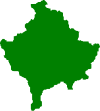| Revision as of 11:09, 1 September 2022 editA storm in a tea-cup (talk | contribs)128 editsNo edit summaryTags: Reverted Visual edit← Previous edit | Revision as of 11:09, 1 September 2022 edit undoA storm in a tea-cup (talk | contribs)128 editsNo edit summaryTags: Reverted Visual editNext edit → | ||
| Line 7: | Line 7: | ||
| Due to ] making up the majority of Kosovo's population, the culture tends to be Albanian with slight variations. | Due to ] making up the majority of Kosovo's population, the culture tends to be Albanian with slight variations. | ||
| According to a survey carried out in 2005 by the Kosovo Statistics Office. The total population of Kosovo is between 1.9 to 2.2 million inhabitants with the following ethnic composition: Albanians 92%, Serbs 4%, Bosnians and Galanios 2%, Turks 1%, Rome 1%. The CIA World Factbook estimates the following percentages: 88% Albanians, 8% Serbs of Kosovo and 4% of other ethnic groups. According to the most recent CIA The World Factbook in July 2009, the population of Kosovo is 1,804,838 inhabitants. | According to a survey carried out in 2005 by the Kosovo Statistics Office. The total population of Kosovo is between 1.9 to 2.2 million inhabitants with the following ethnic composition: Albanians 92%, Serbs 4%, Bosnians and Galanios 2%, Turks 1%, Rome 1%. The CIA World Factbook estimates the following percentages: 88% Albanians, 8% Serbs of Kosovo and 4% of other ethnic groups. According to the most recent CIA The World Factbook in July 2009, the population of Kosovo is 1,804,838 inhabitants. With an ethnic composition of "Albanians 88%, Serbs 7%, another 5%(Bosnios, Gorani, Rome, Turk, Ashkali, Egyptians, Janjevci - Croatas)". | ||
| == See also == | == See also == | ||
Revision as of 11:09, 1 September 2022
| Part of a series on the |
| Culture of Kosovo |
|---|
 |
| History |
| People |
| Languages |
| Mythology and folklore |
| Cuisine |
| Festivals |
| Religion |
| Art |
| Literature |
| Music |
| Media |
| Sport |
| Monuments |
| Symbols |
The Culture of Kosovo refers to the culture of Kosovo. It encompasses the ancient heritage, architecture, literature, visual arts, music, cinema, sports and cuisine of Kosovo. Because of its history and geography, it represents a blend of different cultural spheres especially of the western and eastern culture.
The society of Kosovo has undergone considerable changes over the last centuries, one of the most notable being the increasing level of secularity. The national identity revolves more around the language and culture, than the religion.
Due to Albanians making up the majority of Kosovo's population, the culture tends to be Albanian with slight variations.
According to a survey carried out in 2005 by the Kosovo Statistics Office. The total population of Kosovo is between 1.9 to 2.2 million inhabitants with the following ethnic composition: Albanians 92%, Serbs 4%, Bosnians and Galanios 2%, Turks 1%, Rome 1%. The CIA World Factbook estimates the following percentages: 88% Albanians, 8% Serbs of Kosovo and 4% of other ethnic groups. According to the most recent CIA The World Factbook in July 2009, the population of Kosovo is 1,804,838 inhabitants. With an ethnic composition of "Albanians 88%, Serbs 7%, another 5%(Bosnios, Gorani, Rome, Turk, Ashkali, Egyptians, Janjevci - Croatas)".
See also
- Cultural Heritage of Kosovo
- Architecture of Kosovo
- Literature of Kosovo
- Culture of Kosovo Serbs
- Culture of Albania
- Culture of Serbia
- Culture of the Western Balkans (disambiguation)
Annotations
References
- "Freedom of Thought 2014 report (map)". Freedom of Thought. Archived from the original on 2017-10-10. Retrieved 2018-02-10.
- Judah, Tim. "Albanians." Kosovo: What Everyone Needs to Know. Oxford: Oxford UP, 2008.
| Culture of Europe | |
|---|---|
| Sovereign states |
|
| States with limited recognition | |
| Dependencies and other entities | |
| Other entities | |
This Kosovo-related article is a stub. You can help Misplaced Pages by expanding it. |
This culture-related article is a stub. You can help Misplaced Pages by expanding it. |